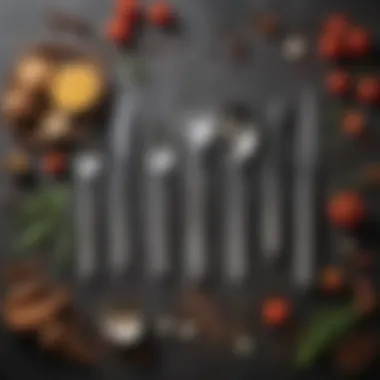Essential Kitchen Utensils for Children: A Guide


Intro
Cooking is not limited to adults. Children have a natural curiosity about food and how it's prepared. Providing them with the right kitchen utensils is essential for nurturing this curiosity. The right tools enable children to engage safely and purposefully in the cooking process. This guide will illuminate the specific utensils that cater to younger cooks. It will also cover safety measures and tips to enhance the cooking experience.
Kids can develop culinary skills and creativity in the kitchen. Selecting the appropriate utensils not only promotes safety but also enhances their confidence. Age-appropriate tools allow children to participate actively under supervision. The design and material of kitchen utensils are also vital aspects to consider. Using the right utensils can make a significant difference in the enjoyment and ease of cooking for young chefs.
In this article, we will explore:
- Essential kitchen utensils designed for children
- Safety considerations when selecting equipment
- Tips to foster a creative cooking environment
Through careful categorization of utensils, this guide aims to aid parents and educators in making informed choices that will ultimately encourage young cooks.
Preamble to Child's Kitchen Utensils
The use of kitchen utensils designed specifically for children holds significant relevance in the domain of child development. Young chefs can learn valuable cooking skills and foster creativity in the kitchen. Educators and parents play a crucial role in bridging the gap between culinary engagement and safety. Selecting appropriate tools can greatly impact a child's willingness to experiment with food.
With the right kitchen utensils, children grasp cooking concepts that enhance their motor skills and confidence. These utensils must cater to both safety and functionality. Therefore, understanding the various options available is vital.
Importance of Cooking Skills in Early Development
Culinary skills are essential in early childhood development. Cooking engages multiple senses, promoting cognitive growth. Children learn to follow instructions, measure ingredients, and develop coordination.
In addition, cooking teaches responsibility. Children become aware of hygiene and clean-up routines. The act of preparing food also fosters a sense of accomplishment. Skills learned in the kitchen can translate into better problem-solving abilities in other areas of life.
Encouraging children to participate in cooking creates a positive association with food. This can lead to healthier eating habits over time. Studies have shown that children who engage in cooking are more likely to choose fruits and vegetables as part of their diet.
Overview of Child-Specific Kitchen Tools
Child-specific kitchen tools are designed to enhance safety and functionality for young cooks. These utensils have unique features that simplify the cooking process. The primary goal is to provide children with a fun and engaging way to develop their culinary skills.
Some commonly used child-specific utensils include:
- Child-safe knives: These utensils have rounded edges and are designed to prevent cuts while allowing children to practice slicing.
- Measuring cups and spoons: Often brightly colored and easy to hold, these tools help children learn about portions and measurements.
- Mixing bowls: Lightweight options are available, making it easier for children to mix ingredients without risk of spills.
Specialty items also cater to young chefs. For baking, cookie cutters and mini rolling pins offer fun ways to engage with dough. Understanding the available tools helps to create an ideal cooking environment for children.
"Choosing the right utensils is foundational for nurturing culinary exploration and maintaining safety."
By selecting appropriate kitchen utensils, caregivers promote not only skill development but also an enduring interest in cooking that may last a lifetime.
Types of Child's Kitchen Utensils
Understanding the types of kitchen utensils designed for children is crucial for fostering a safe and enjoyable cooking experience. Each category of utensils serves a specific purpose that not only aids in daily meal preparation but also enhances cognitive and motor skills in young cooks. This section categorizes the essential utensils into several groups, such as cutting instruments, measuring devices, mixing tools, cooking implements, and baking tools.
Selecting the correct utensils according to these types can significantly impact a child's culinary confidence. Safety, ease of use, and effectiveness are key elements when choosing these tools. Moreover, age-appropriate options ensure that children engage with cooking in a manner conducive to their growth and learning.
Cutting Instruments
Cutting instruments are foundational tools in the kitchen. Teaching children to use cutting utensils not only helps develop their dexterity but also encourages independence in meal preparation.
Child-Safe Knives
Child-safe knives are specially designed for young cooks. They often feature rounded tips and serrated edges, making them ideal for cutting softer fruits and vegetables. The primary benefit of using these knives is safety; they drastically reduce the risk of cuts while allowing kids to learn essential cooking skills.
A key characteristic of child-safe knives is their ergonomic handles, which fit comfortably in small hands, promoting better grip and control. These knives are popular because they strike a good balance between functionality and safety. However, adult supervision is still required to ensure proper technique.


Cutting Boards for Kids
Cutting boards for kids come in fun colors and designs, making the cooking process inviting. They are usually made from safe, durable materials that are easy to clean. A specific aspect of these cutting boards is their non-slip surface, which ensures stability while chopping.
This characteristic makes them suitable for young chefs, as it minimizes accidents. In contrast to regular cutting boards, children's versions may be smaller, facilitating ease of use. Nonetheless, it is essential to ensure that the materials used are non-toxic and free from harmful chemicals.
Measuring Devices
Measuring devices are vital for teaching children the basics of cooking and baking. Accurate measurements are crucial to ensure successful recipes while enhancing numerical skills in the process.
Measuring Cups and Spoons
Measuring cups and spoons are designed with children in mind, often made from colorful, lightweight materials that are easy to handle. This aspect encourages children to participate in the cooking process actively.
The key characteristic of these measuring tools is their clear volume measurements, which aid in education about quantities. Their availability in various shapes and sizes makes cooking more fun. One small drawback could be that some children may struggle to read the measurements accurately initially.
Scales Suitable for Children
Scales suitable for children provide another level of measurement accuracy. These scales can often include large displays and simple buttons, allowing for straightforward use. A significant aspect of kid-friendly scales is their lightweight nature and non-slip bases.
This makes them safe and stable for young cooks. Using a scale helps children understand the concept of weight, which is crucial for many recipes. However, like all devices, them require supervision and guidance to ensure proper usage.
Mixing Tools
Mixing tools play a vital role in the preparation of various dishes. Teaching children how to mix ingredients effectively is essential for fostering culinary creativity.
Bowls Intended for Young Chefs
Bowls intended for young chefs are typically made from lightweight, flexible materials that make them easy to handle. One specific aspect is their vibrant colors and designs, which excite a child’s interest in cooking.
These bowls are deeper than standard bowls, preventing spills and messes during mixing. Their unique feature often includes measurement markings inside, which can help children learn about quantities while they cook. On the downside, some may be less durable than heavier materials.
Handheld Mixers and Whisks
Handheld mixers and whisks are beneficial tools for teaching children how to combine ingredients. They are often designed with safety features such as rounded edges and lightweight properties.
A distinctive characteristic of child-friendly mixers is their adjustable speed settings, allowing children to learn about mixing techniques safely. Whisks made from flexible materials also let kids enjoy the mixing experience without frustration. However, depending on the age and capability of the child, supervision is essential when using these tools.
Cooking Implements
Cooking implements are essential for safely preparing foods on the stove. Age-appropriate tools contribute to a child's confidence and capability in the kitchen.
Child-Sized Pans and Pots
Child-sized pans and pots are tailored for small hands, facilitating easier cooking. They often come with short handles and lightweight construction, ensuring safety during use. A significant aspect of these cooking implements is the non-stick surface, which makes it easier to cook without food sticking and simplifies cleaning.
This is beneficial for children, as it reduces frustration during the cooking process. However, they may not always hold larger quantities of food, which can limit their usage as children's cooking skills advance.
Spatulas and Spoons
Spatulas and spoons designed for children often have softer edges and sturdy handles. Their size is ideal for little hands. This characteristic promotes better handling when mixing or flipping food, ultimately aiding in learning basic cooking techniques.
The key uniqueness of these tools is their vibrant colors and designs that appeal to kids. However, some parents may find that child-sized tools can be less effective for larger tasks.
Baking Tools


Baking can be an exciting and educational experience for children. Choosing the right baking tools is essential for a successful baking session.
Cookie Cutters
Cookie cutters are an exciting tool that encourages creativity in baking. They come in various shapes and sizes, making the process of cutting dough fun. A key feature is often their larger, safer edges, which prevent finger injuries compared to standard cookie cutters.
These vibrant options make them a popular choice for engaging children in baking activities. However, the disadvantage could be that some shapes may be less practical for older children who wish to create more intricate designs.
Mini Rolling Pins
Mini rolling pins are perfect for small hands. They allow children to learn the aspect of rolling and flattening dough easily. The primary characteristic of these pins is their manageable length, which helps with greater control.
This makes them a beneficial tool in the baking process. One downside may be that they may not work as effectively for larger batches of dough, limiting their use.
Safety Considerations When Using Kitchen Utensils
Involving children in the kitchen can be a rewarding experience, but it also demands attention to safety considerations. When selecting kitchen utensils for children, parents must prioritize safety to prevent accidents and injuries. Child-specific tools are designed with a focus on minimizing hazards, therefore fostering a safer cooking environment. Age-appropriate utensils not only facilitate learning but also help build confidence as children navigate their culinary tasks. This section will focus on the importance of choosing the right materials, avoiding sharp edges, and understanding supervision requirements to maximize safety.
Material Safety
Choosing Non-Toxic Materials
Choosing non-toxic materials is crucial when outfitting a child's kitchen. Many plastics and materials contain harmful chemicals that can leach into food. Non-toxic materials like food-grade silicone and stainless steel are safe alternatives. These materials do not release any harmful substances, ensuring that children are not exposed to toxins.
The key characteristic of non-toxic utensils is their safety and health standards. This makes them a favorable choice for parents interested in providing safe culinary experiences for their children. In terms of advantages, these materials are often durable and can withstand heat, thus rendering them practical for a variety of cooking tasks. However, they may come at a slightly higher price point, which can deter some buyers.
Sustainable and Eco-Friendly Options
Sustainable and eco-friendly options in children's kitchen utensils contribute positively to both health and environment. Materials such as bamboo, recycled plastics, and plant-based composites are great examples. These options reduce the impact on the planet while ensuring the health of young cooks.
The key characteristic of sustainable utensils is their environmentally responsible production methods. This makes them a sought-after choice among eco-conscious parents. A unique feature of many eco-friendly products is their biodegradability, which gives them an edge in terms of sustainability. The main advantage is that they not only serve the needs of young chefs but also promote a broader awareness of environmental responsibility. However, they may require slightly more care in terms of cleaning and maintenance compared to traditional materials.
Avoiding Sharp Edges
Avoiding sharp edges in kitchen utensils designed for children is another critical safety consideration. Many traditional tools apply sharp blades and edges that can pose serious risks. For children's kitchen utensils, manufacturers often replace standard blades with dull edges or rounded designs. This approach effectively mitigates the risk of cuts or injuries. Parents should continually remind children about the importance of using tools correctly—such as cutting away from their bodies.
Supervision Requirements
No matter how safe the utensils may be, adult supervision is essential when children are in the kitchen. Supervision ensures that children use tools correctly and adhere to safety practices. It also provides an opportunity for adults to educate their kids about kitchen safety while enhancing the overall cooking experience. Quick instructions on handling tools properly can significantly reduce the chances of accidents.
"A safe kitchen is the best kitchen for children to learn and explore culinary skills."
Both the emotional and developmental benefits from cooking activities can flourish in a secure environment where safety is the top priority.
Selecting Appropriate Utensils for Different Age Groups
Choosing the right kitchen utensils for children is crucial. Each age group has unique needs and abilities that should inform the selection process. When children use utensils designed for their specific developmental stage, they gain confidence and enhance their culinary skills. Moreover, age-appropriate tools significantly contribute to safety in the kitchen. Using utensils made to suit their grasp and cognitive abilities can reduce accidents and make cooking a more enjoyable experience. This section explores what utensils are best suited for toddlers, preschoolers, and school-age children.
Utensils for Toddlers
Toddlers are often eager to experiment with cooking, but they require specially designed utensils to ensure safety. Items for this age group should be lightweight and easy for small hands to manage. Additionally, materials should be non-toxic and robust.
Key utensils include:
- Soft-bladed knives: These are specifically made to cut through soft fruits like bananas or cooked vegetables, promoting independence.
- Silicone spatulas: They are gentle on surfaces and offer toddlers a safe option to mix or flip ingredients.
- Plastic measuring cups: These can be easily handled and are perfect for introducing measurement concepts without the risk of breaking.


When selecting these tools, parents should also supervise their toddlers closely. Encouraging them to participate can be delightful, but safety should always come first.
Utensils for Preschoolers
Once children enter preschool, their skills begin to develop further. They can tackle slightly more complex tasks in the kitchen. At this age, utensils should still prioritize safety while encouraging creativity and learning.
Essential utensils for preschoolers include:
- Child-safe knives with blunt edges, allowing kids to practice cutting fruits and vegetables while minimizing risk.
- Sturdy mixing bowls that can withstand vigorous stirring and help in teaching them the art of mixing.
- Kid-friendly baking tools, like mini rolling pins and small cookie cutters, introduce them to baking in a fun way.
This age group requires a balance between challenge and safety, fostering their growing independence while maintaining a secure environment.
Utensils for School-Age Children
School-age children usually have more developed motor skills and a better understanding of kitchen tasks. This allows them to use utensils similar to adult versions, but there are still considerations for safety and suitability.
Recommended utensils for this group include:
- Sharp-but-safe knives that allow kids to practice their cutting skills under supervision while avoiding serious injuries.
- Standard mixing tools, such as whisks and wooden spoons, are appropriate for older children, encouraging them to experiment with different textures and flavors.
- Proper baking sets including measuring scales and sophisticated baking trays, allow school-age children to refine their baking skills.
Encouraging Creativity in the Kitchen
Encouraging creativity in the kitchen is essential when it comes to young cooks. The act of cooking serves not just as a practical skill, but as a means of self-expression and exploration. Kids exposed to creative cooking environments are more likely to develop a love for food and cooking that can last a lifetime. Unique kitchen utensils enhance these experiences by allowing them to experiment freely, thus fostering creativity.
Incorporating Fun Activities
The incorporation of fun activities into cooking is a vital avenue for creativity. It transforms the kitchen into an experimental space where children can see cooking as an enjoyable rather than a chore. When children engage in fun culinary projects, they can learn vital skills while also having a good time. Their confidence grows slowly as they see the impact of their creativity.
Fun Recipes for Kids
Fun recipes for kids typically feature easy-to-follow procedures and vibrant ingredients that capture children's attention. These recipes often allow for variation, letting kids personalize their cooking. For instance, pizza-making allows them to choose their toppings, cultivating a sense of ownership over their meal.
The key characteristic of these recipes is simplicity. By using straightforward ingredients and step-by-step instructions, kids can engage with the process without feeling overwhelmed. This approach not only empowers children to be active participants but also enhances their problem-solving skills. However, care must be taken that the recipes remain balanced; fun should not overshadow nutrition.
Themed Cooking Sessions
Themed cooking sessions offer a unique twist on regular meal preparation. By aligning cooking with themes—like Italian night or a specific holiday—kids can explore various cuisines while also understanding cultural contexts. These sessions foster teamwork, as kids work together to create a cohesive meal.
The appealing aspect of themed sessions is their ability to transform the mundane into something exciting. They often feature decorations, unique serving styles, and music which create an immersive experience. The potential downside, however, is the need for planning and resources, which might deter some families. Still, for those willing to invest the time, the rewards in engagement and creativity can be substantial.
Fostering Independence and Confidence
Fostering independence and confidence in young cooks is crucial. Allowing children to take charge of their cooking teaches them a sense of responsibility. In doing so, they learn to make their own choices and become comfortable in a kitchen setting. As they master skills, so too does their self-esteem. The ability to create meals independently provides a powerful boost to their confidence and life skills.
Epilogue
The importance of the conclusion in this article lies in summarizing the vast information presented about child's kitchen utensils. A well-rounded conclusion encapsulates the critical insights explored throughout. It strengthens the reader's understanding of why specific utensils foster both safety and creativity in the kitchen for children.
Through the analysis of various types of kitchen tools, safety measures, age-appropriate selections, and encouragement of creativity, readers are equipped to make informed decisions. Proper utensils enhance a child's cooking experience, contributing positively to their cognitive and emotional development.
Recap of Key Points
Throughout the discussion, several key elements emerge:
- Child-Specific Tools: Unique utensils designed specifically for children prioritize safety and ease of use.
- Safety Considerations: Material safety and avoiding sharp edges are paramount for child-friendly cooking.
- Age Appropriateness: Utensils must be carefully selected based on the child’s age to foster independence without compromising safety.
- Encouraging Creativity: Utilizing fun recipes and themed sessions can make cooking an enjoyable and creative outlet.
Final Thoughts on Child's Kitchen Utensils
The journey of cooking can be a delightful bonding experience, where skills are learned, and memories are created.
This thoughtful approach aids in developing a love for cooking that can last a lifetime. As children experiment in the kitchen, they cultivate not only their culinary abilities but also critical life skills such as creativity, patience, and teamwork.















